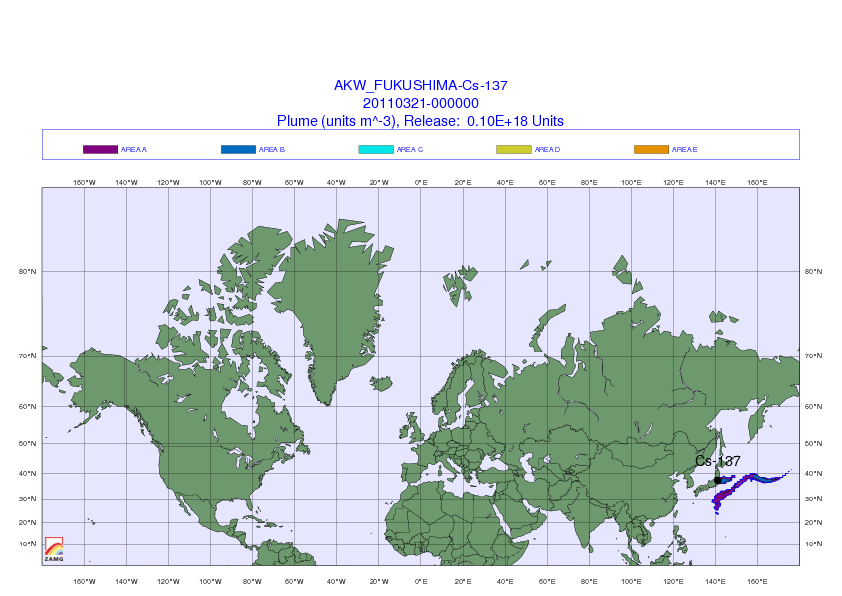As I've previously noted, many experts say that the Fukushima plants will keep on leaking for months. See this and this.
And the amount of radioactive fuel at Fukushima dwarfs Chernobyl.
As the New York Times notes, radioactive cesium is the main danger from the Japanese nuclear accident:
So it is bad news indeed that, as reported by New Scientist, cesium fallout from Fukushima already rivals Chernobyl:
Over the long term, the big threat to human health is cesium-137, which has a half-life of 30 years.
At that rate of disintegration, John Emsley wrote in “Nature’s Building Blocks” (Oxford, 2001), “it takes over 200 years to reduce it to 1 percent of its former level.”
It is cesium-137 that still contaminates much of the land in Ukraine around the Chernobyl reactor.
***
Cesium-137 mixes easily with water and is chemically similar to potassium. It thus mimics how potassium gets metabolized in the body and can enter through many foods, including milk.
Radioactive caesium and iodine has been deposited in northern Japan far from the Fukushima Daiichi nuclear plant, at levels that were considered highly contaminated after Chernobyl.
The readings were taken by the Japanese science ministry, MEXT, and reveal high levels of caesium-137 and iodine-131 outside the 30-kilometre evacuation zone, mostly to the north-north-west.
***
After the 1986 Chernobyl accident, the most highly contaminated areas were defined as those with over 1490 kilobecquerels (kBq) of caesium per square metre. Produce from soil with 550 kBq/m2 was destroyed.
People living within 30 kilometres of the plant have evacuated or been advised to stay indoors. Since 18 March, MEXT has repeatedly found caesium levels above 550 kBq/m2 in an area some 45 kilometres wide lying 30 to 50 kilometres north-west of the plant. The highest was 6400 kBq/m2, about 35 kilometres away, while caesium reached 1816 kBq/m2 in Nihonmatsu City and 1752 kBq/m2 in the town of Kawamata, where iodine-131 levels of up to 12,560 kBq/m2 have also been measured. "Some of the numbers are really high," says Gerhard Proehl, head of assessment and management of environmental releases of radiation at the International Atomic Energy Agency.
While Japan has been exposed to very high levels of cesium, so far, the levels of cesium in other parts of the world appear to be relatively low:
But anyone who believes that Fukushima cannot possibly become as bad as Chernobyl has no idea what they are talking about.


Regarding the animation in the blue square:
ReplyDeleteit was done by the "Rhenish Institute for Environmental Reasearch at the University of Cologne" in Germany.
In the report it states: "The release rate is estimated as 1015 Bq/d. This is appr. one tenth of the Chernobyl release. This simulation is a so called "worst case scenario" with continuous release rate. The value of 0.001 Bq/m3 correspond to appr. one millionth of the concentration at the source. At distances more than appr. 2000 km away from the source, the concentrations are not harmful to health."
Check: http://www.eurad.uni-koeln.de/index_e.html for the direct link as updates will occur as data becomes available.
About the very last part:
ReplyDelete"...anyone who believes that Fukushima cannot possibly become as bad as Chernobyl..."
It is commonly said by people who clearly have read plenty (I've seen this about 8 times/8 sites) that in Chernobyl the *fire* of graphite hugely increased the dispersion.
So regardless of the fact of much more fuel at this Japanese complex (in total at the 6 reactors and their pools), a common thought is that even with a serious meltdown (a full meltdown of one core, and then perhaps even more trouble at other reactors), you still are unlikely to have anything similar to Chernobyl's fire.
In other words, you don't have an obvious means of dispersing heavier radionuclides in more than tiny quantities -- what will carry the heavier elements in larger bulk? Roughly, one impression I got on that is you need smoke, ash, etc., to carry the heavier stuff. Steam would not do it. You'd need fire or explosion, etc.
Have you seen something contrary to this?